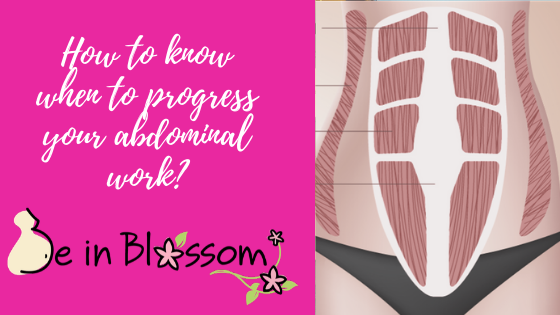
When to progress your Abdominal Work?
Determining the level of difficulty to exercise your abdominal wall after having a baby is not simply a case of linking your progress to the number of weeks or months you are post-birth. There is no recipe to follow and this is why you will notice so many variations going on particularly in our Mummy Core & Conditioning classes.
Factor Indicators When Programming & Ready to Next Level
Here are some factors that we consider when programming and some signs to look for to tell if you are ready to move on to the next level.
When ladies first start classes our assessment form or telephone interview will capture “red flags” or areas we need to be mindful of. Someone who has the potential to have more vaginal wall laxity or bladder leakage needs a different strategy to someone else who has difficulty relaxing their pelvic floor muscles. Abdominal muscle separation, number of pregnancies, baby weights, exercise history, presence or history of pain and social factors plus many more all influence the approach that is taken to your abdominal wall rehabilitation. Having the opportunity to do a screening appointment then provides information on your baseline control, the state of your abdominal wall, rib cage movement, body awareness and a sense of your overall well-being. So many things going on in our heads for all the ladies in class!
There is not a set of exercises that are the right ones to do or a set that is blacklisted. Rather there is a place to start and to progress. OK so let’s look at the indicators for progressing the exercise:
Let's Look at the indicators for progressing the exercise:
- Achieving the set number of repetitions with good control and technique
- Capable of managing your breath (not breath-holding, good breathing pattern)
- No bulging of your abdomen down the midline (Bulging can be abdominal contents pressing up into a diastasis/gap between the outer abdominal muscles. A broader bulging can also be a dominance of the rectus abdominal muscles (outermost layer or your abs that run up and down closest to the midline) with poor core contraction.
- No involution in the midline of your tummy where the connective tissue may have been stretched.
- Capable of maintaining a tensioned/flattened appearance to the abdomen indicating the deep abdominals are working.
- Able to keep a gentle curve in your lower back (no arching up from the starting position) No sense of vaginal pressure either at the time you are exercising or later. (Sometimes the new exercise feels fine at the time but later in the day you may notice that there is some heaviness)
Pregnancy Core Training
Many of us associate our core with our 6-pack muscles. Perhaps you associate abdominal exercises with sit-ups, crunches, and planks. But our core is much more than just our six-pack, and it's beneficial to do a well-rounded suite of core exercises during pregnancy (and really, for anyone).
Let us first define the core.
Our core is literally the centre of our bodies. It serves as the foundation upon which we generate power in our limbs and carry out all of our distal movements. It isn't just for show. Our core is made up of several muscle layers. The innermost layer, known as the inner core canister, is in charge of stabilizing our spine and torso, controlling continence (keeping us dry! ), and supporting our pelvic organs. These muscles are stretched during pregnancy, their coordination is disrupted, and a breakdown in their smooth functioning leads to common pregnancy symptoms such as leaking urine, low back pain, and feelings of heaviness through the vagina and pelvic floor. Although not strictly a member of the inner core canister, the glutes (butt muscles) collaborate with these muscles and are frequently referred to as the inner core's best friends. If we want to build a strong and functional core, we can't forget about the glutes when we plan our core exercises.
How the core should work?
When you inhale, the diaphragm contracts downward and the pelvic floor and transverse abdominals lengthen reflexively (pelvic floor releases slightly down, transverse abs release slightly outwards). The diaphragm contracts upwards on exhalation, while the pelvic floor and transverse abdominals recoil and contract upward and inward, respectively. Every exhale works your pelvic floor and innermost abs if you are breathing in a coordinated manner. Furthermore, they are experiencing their full range of motion on each breath cycle, which means they are optimized to function well and respond to fluctuations in demands placed on them by exercise or daily activities. When you do difficult things, your core should function reflexively (without conscious effort) to anticipate increased demands. To stabilize your spine and provide support for your task, your pelvic floor and transverse abs should co-contract just before lifting a heavy load, for example. Pregnancy frequently throws a wrench in your core's coordination and reflexive response, which is why core training during pregnancy and postpartum is so important for maintaining and rebuilding strength in these muscles.
The fundamental core exercise is breathing.
The Connection Breath is the most fundamental core exercise during pregnancy, and it is required for all higher-level moves. This breath is a tool for managing the pressure that builds up in your abdomen during exercise. If this pressure is not well managed, it manifests as doming through the abdominal midline or pressure through the pelvic floor. Poor pressure management can lead to conditions such as diastasis recti or pelvic organ prolapse in the long run. Begin with a deep inhale to prepare for the connection breath. Allow your rib cage to expand 360 degrees (like an umbrella opening) on your inhale while relaxing your belly and pelvic floor. Gently contract your pelvic floor (kegel) as you exhale. It may appear simple, but if this is your first time, it may feel a little like patting your head and rubbing your belly.
Our core stabilizes us in all directions.
The inner core works to keep our bodies stable in multiple planes of motion. Front to back, side to side, and rotational. It can also induce hip flexion, side bends, and rotation. We must work in all of these planes when doing intentional core strengthening. During pregnancy, it is critical to focus on stabilizing functions and train the anti-extension (front-and-back), anti-lateral flexion (side-to-side), and anti-rotational components. I also like to include rotational training because it is a type of movement that parents do on a regular basis.
What ab exercises are safe to do during pregnancy? Are there any ab exercises to avoid while pregnant?
The answer to this question is somewhat dependent on where you are in your pregnancy. From the first to the third trimester, the core work will change slightly. Core work will most likely look similar to what you were doing prior to pregnancy during the first trimester. As you enter the second trimester, or your baby bump becomes visible, you'll probably need to modify your exercise and/or breathing strategies.
- As your pregnancy progresses, you should start substituting any exercises that put a lot of strain on your abdominal wall. Planks, push-ups, sit-ups, and toes-to-bar are some examples. These exercises apply force to the abdominal wall via gravity or hard-flexion of the spine, and they can strain abdominal muscles that are already under strain from supporting your growing baby.
- After about 20 weeks, you may feel less comfortable on your back and want to stop doing supine (back-lying) exercises. Many back-lying exercises can be done comfortably while propped up at a 15-degree angle.
We frequently ask whether you can do sit-ups while pregnant. Can you do planks while pregnant? Let's change the subject from "can I" to "should I". Consider the additional strain these exercises place on your body, the long-term consequences of damaging key muscles, and the plethora of other exercises you could do instead.
What are the signs and symptoms of an overworked pelvic floor?
It's critical to recognize the signs and symptoms that the core isn't working properly.
Watch out for the four Ps:
- Pain (anywhere really, but specifically in the vagina or perineum) (anywhere really, but specifically in the vagina or perineum)
- Peeing (inadvertent leaking!)
- Pressure (through the vagina, rectum or perineum) (through the vagina, rectum or perineum)
- Peaking (or doming through the midline of your belly) (or doming through the midline of your belly)
If you experience any of these symptoms, it may be time to reconsider how you are performing an exercise, or it may be time to replace an exercise with something more appropriate for your stage of pregnancy. To assist you with troubleshooting and exercise programming, we recommend you seek professional advice from Be In Blossom’s pelvic floor physical therapist or a qualified pregnancy fitness coach. Seek Professional advice today.
